Radisson Blu Hotel: Cost Management, Break-Even and Target Profit
VerifiedAdded on 2023/06/07
|8
|1726
|153
Report
AI Summary
This report provides a comprehensive cost management analysis for Radisson Blu, focusing on cost drivers, cost behavior, and break-even analysis. It categorizes various costs, such as full-time wages, casual employee wages, internet charges, and electricity, as either fixed or variable, identifying occupancy rate and season as key cost drivers. The break-even analysis calculates that the hotel needs to book 108 rooms to cover its costs, considering fixed costs of $24,770 and variable costs of $21,890. Furthermore, the report evaluates two profit-generating options from travel agents, determining that accepting the offer from travel agent A, with a targeted profit of $50,000, is the more financially sound decision due to its potential for maximizing profits, even though it exceeds the hotel's capacity, whereas the second offer is not recommended as it will not lead to profit maximization. Desklib offers a wealth of similar solved assignments and study resources for students.
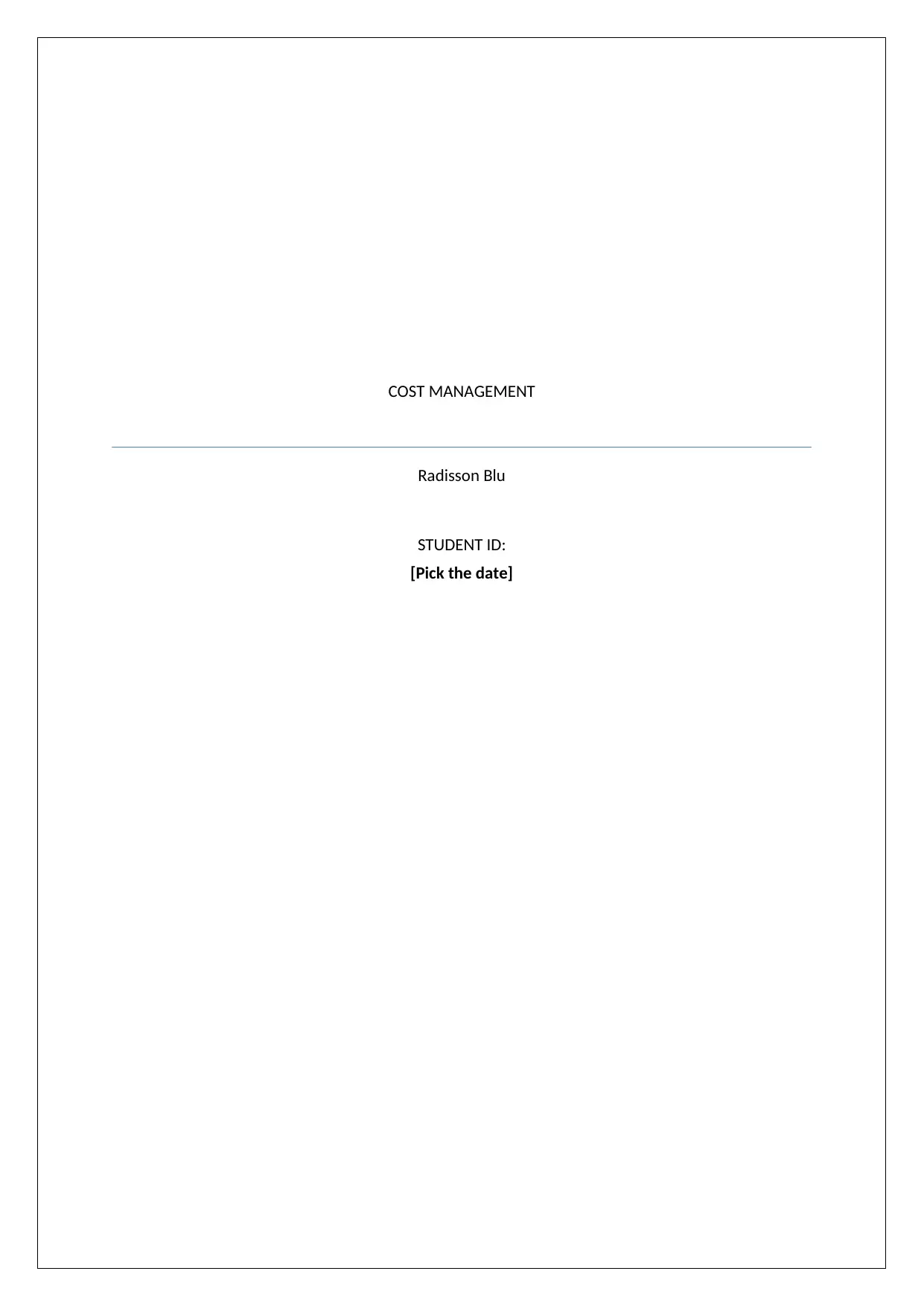
COST MANAGEMENT
Radisson Blu
STUDENT ID:
[Pick the date]
Radisson Blu
STUDENT ID:
[Pick the date]
Paraphrase This Document
Need a fresh take? Get an instant paraphrase of this document with our AI Paraphraser
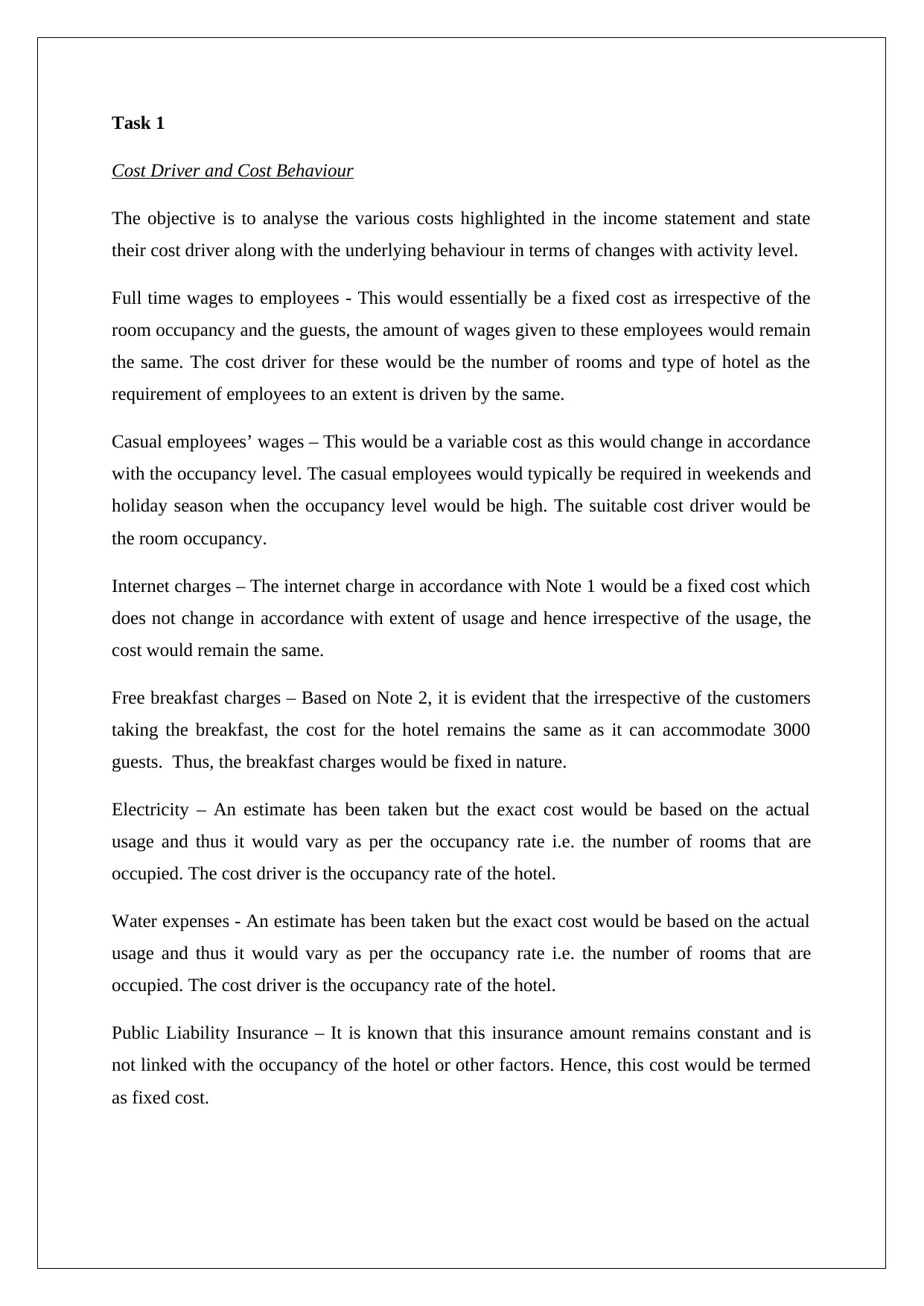
Task 1
Cost Driver and Cost Behaviour
The objective is to analyse the various costs highlighted in the income statement and state
their cost driver along with the underlying behaviour in terms of changes with activity level.
Full time wages to employees - This would essentially be a fixed cost as irrespective of the
room occupancy and the guests, the amount of wages given to these employees would remain
the same. The cost driver for these would be the number of rooms and type of hotel as the
requirement of employees to an extent is driven by the same.
Casual employees’ wages – This would be a variable cost as this would change in accordance
with the occupancy level. The casual employees would typically be required in weekends and
holiday season when the occupancy level would be high. The suitable cost driver would be
the room occupancy.
Internet charges – The internet charge in accordance with Note 1 would be a fixed cost which
does not change in accordance with extent of usage and hence irrespective of the usage, the
cost would remain the same.
Free breakfast charges – Based on Note 2, it is evident that the irrespective of the customers
taking the breakfast, the cost for the hotel remains the same as it can accommodate 3000
guests. Thus, the breakfast charges would be fixed in nature.
Electricity – An estimate has been taken but the exact cost would be based on the actual
usage and thus it would vary as per the occupancy rate i.e. the number of rooms that are
occupied. The cost driver is the occupancy rate of the hotel.
Water expenses - An estimate has been taken but the exact cost would be based on the actual
usage and thus it would vary as per the occupancy rate i.e. the number of rooms that are
occupied. The cost driver is the occupancy rate of the hotel.
Public Liability Insurance – It is known that this insurance amount remains constant and is
not linked with the occupancy of the hotel or other factors. Hence, this cost would be termed
as fixed cost.
Cost Driver and Cost Behaviour
The objective is to analyse the various costs highlighted in the income statement and state
their cost driver along with the underlying behaviour in terms of changes with activity level.
Full time wages to employees - This would essentially be a fixed cost as irrespective of the
room occupancy and the guests, the amount of wages given to these employees would remain
the same. The cost driver for these would be the number of rooms and type of hotel as the
requirement of employees to an extent is driven by the same.
Casual employees’ wages – This would be a variable cost as this would change in accordance
with the occupancy level. The casual employees would typically be required in weekends and
holiday season when the occupancy level would be high. The suitable cost driver would be
the room occupancy.
Internet charges – The internet charge in accordance with Note 1 would be a fixed cost which
does not change in accordance with extent of usage and hence irrespective of the usage, the
cost would remain the same.
Free breakfast charges – Based on Note 2, it is evident that the irrespective of the customers
taking the breakfast, the cost for the hotel remains the same as it can accommodate 3000
guests. Thus, the breakfast charges would be fixed in nature.
Electricity – An estimate has been taken but the exact cost would be based on the actual
usage and thus it would vary as per the occupancy rate i.e. the number of rooms that are
occupied. The cost driver is the occupancy rate of the hotel.
Water expenses - An estimate has been taken but the exact cost would be based on the actual
usage and thus it would vary as per the occupancy rate i.e. the number of rooms that are
occupied. The cost driver is the occupancy rate of the hotel.
Public Liability Insurance – It is known that this insurance amount remains constant and is
not linked with the occupancy of the hotel or other factors. Hence, this cost would be termed
as fixed cost.
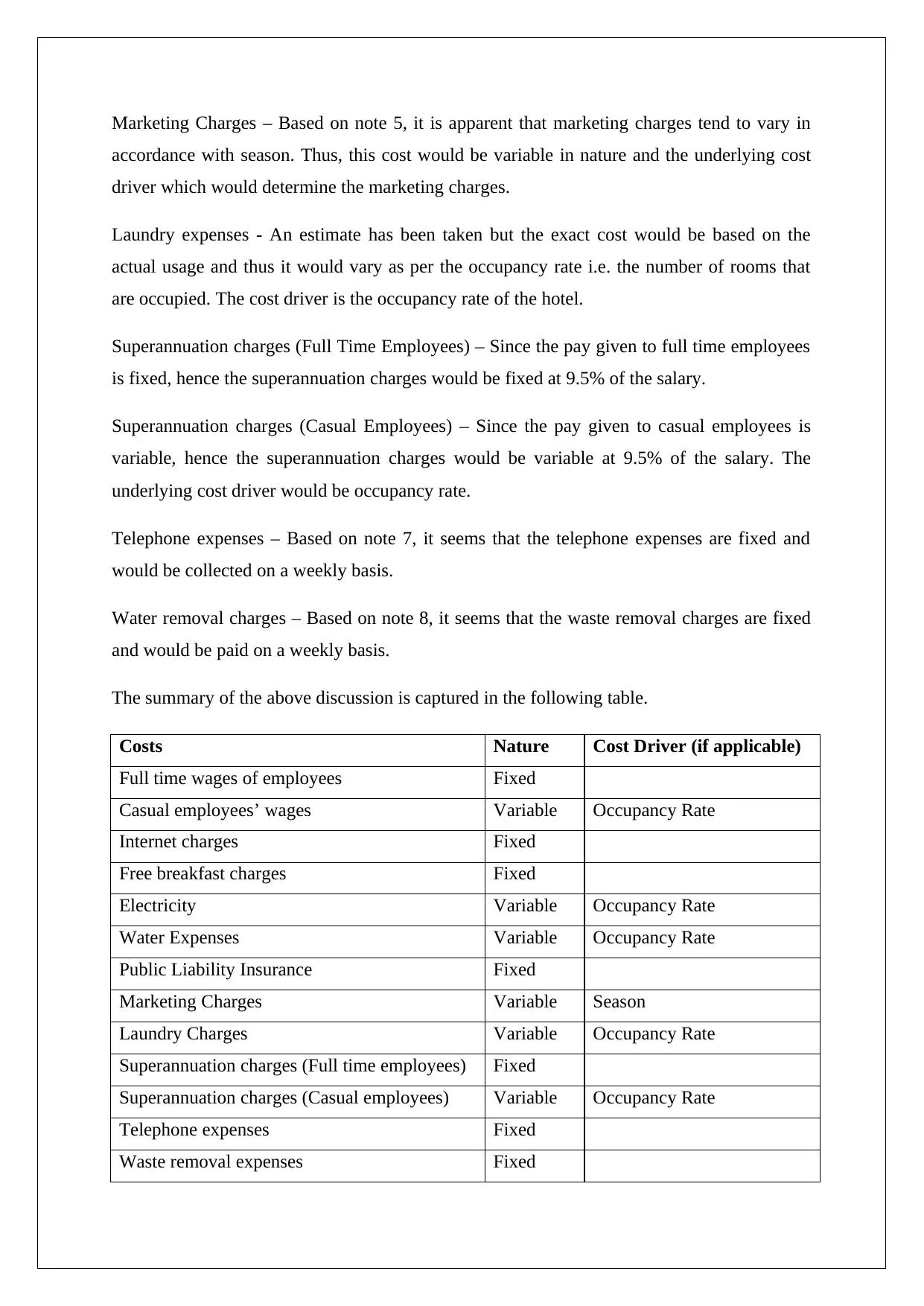
Marketing Charges – Based on note 5, it is apparent that marketing charges tend to vary in
accordance with season. Thus, this cost would be variable in nature and the underlying cost
driver which would determine the marketing charges.
Laundry expenses - An estimate has been taken but the exact cost would be based on the
actual usage and thus it would vary as per the occupancy rate i.e. the number of rooms that
are occupied. The cost driver is the occupancy rate of the hotel.
Superannuation charges (Full Time Employees) – Since the pay given to full time employees
is fixed, hence the superannuation charges would be fixed at 9.5% of the salary.
Superannuation charges (Casual Employees) – Since the pay given to casual employees is
variable, hence the superannuation charges would be variable at 9.5% of the salary. The
underlying cost driver would be occupancy rate.
Telephone expenses – Based on note 7, it seems that the telephone expenses are fixed and
would be collected on a weekly basis.
Water removal charges – Based on note 8, it seems that the waste removal charges are fixed
and would be paid on a weekly basis.
The summary of the above discussion is captured in the following table.
Costs Nature Cost Driver (if applicable)
Full time wages of employees Fixed
Casual employees’ wages Variable Occupancy Rate
Internet charges Fixed
Free breakfast charges Fixed
Electricity Variable Occupancy Rate
Water Expenses Variable Occupancy Rate
Public Liability Insurance Fixed
Marketing Charges Variable Season
Laundry Charges Variable Occupancy Rate
Superannuation charges (Full time employees) Fixed
Superannuation charges (Casual employees) Variable Occupancy Rate
Telephone expenses Fixed
Waste removal expenses Fixed
accordance with season. Thus, this cost would be variable in nature and the underlying cost
driver which would determine the marketing charges.
Laundry expenses - An estimate has been taken but the exact cost would be based on the
actual usage and thus it would vary as per the occupancy rate i.e. the number of rooms that
are occupied. The cost driver is the occupancy rate of the hotel.
Superannuation charges (Full Time Employees) – Since the pay given to full time employees
is fixed, hence the superannuation charges would be fixed at 9.5% of the salary.
Superannuation charges (Casual Employees) – Since the pay given to casual employees is
variable, hence the superannuation charges would be variable at 9.5% of the salary. The
underlying cost driver would be occupancy rate.
Telephone expenses – Based on note 7, it seems that the telephone expenses are fixed and
would be collected on a weekly basis.
Water removal charges – Based on note 8, it seems that the waste removal charges are fixed
and would be paid on a weekly basis.
The summary of the above discussion is captured in the following table.
Costs Nature Cost Driver (if applicable)
Full time wages of employees Fixed
Casual employees’ wages Variable Occupancy Rate
Internet charges Fixed
Free breakfast charges Fixed
Electricity Variable Occupancy Rate
Water Expenses Variable Occupancy Rate
Public Liability Insurance Fixed
Marketing Charges Variable Season
Laundry Charges Variable Occupancy Rate
Superannuation charges (Full time employees) Fixed
Superannuation charges (Casual employees) Variable Occupancy Rate
Telephone expenses Fixed
Waste removal expenses Fixed
⊘ This is a preview!⊘
Do you want full access?
Subscribe today to unlock all pages.

Trusted by 1+ million students worldwide
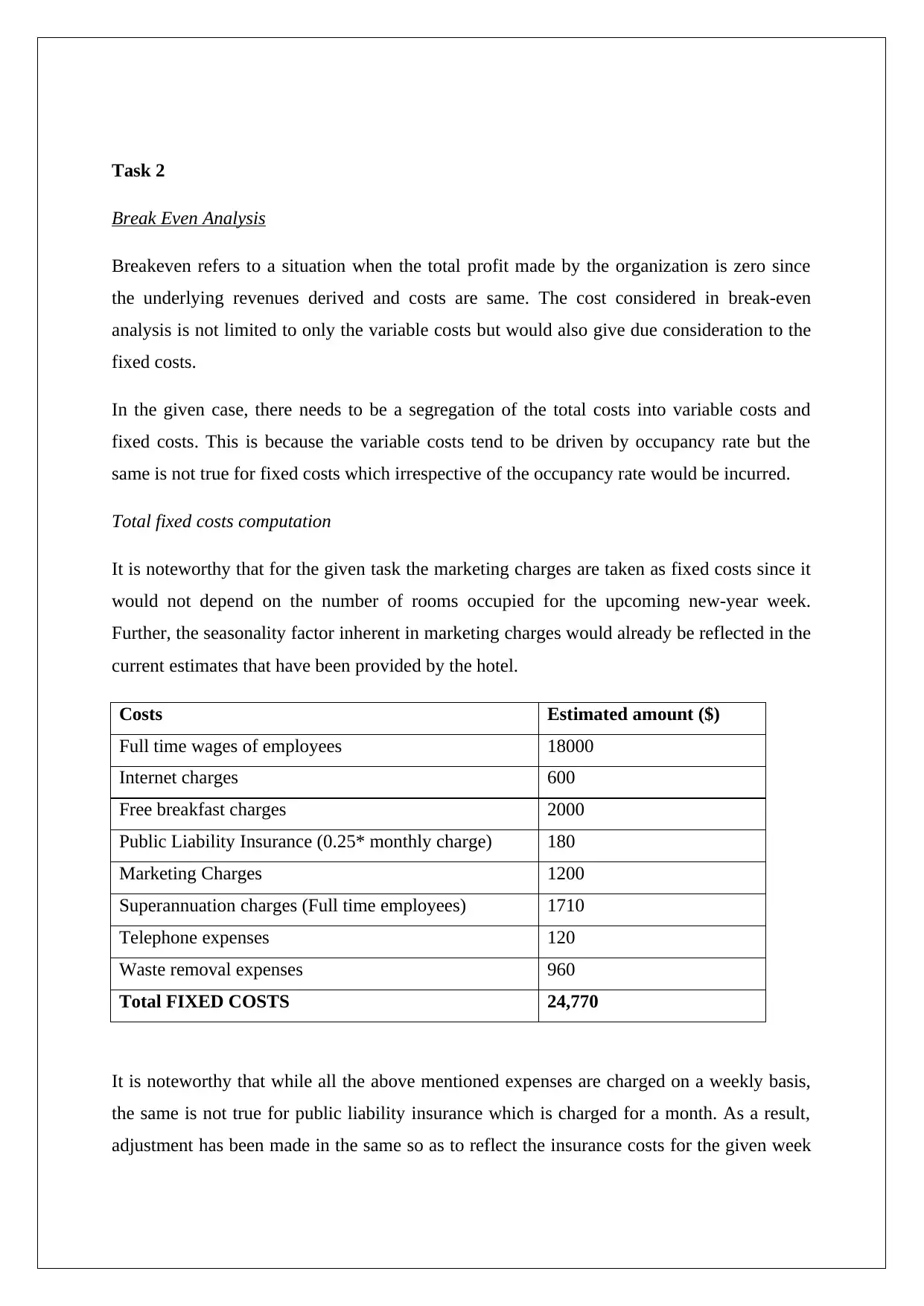
Task 2
Break Even Analysis
Breakeven refers to a situation when the total profit made by the organization is zero since
the underlying revenues derived and costs are same. The cost considered in break-even
analysis is not limited to only the variable costs but would also give due consideration to the
fixed costs.
In the given case, there needs to be a segregation of the total costs into variable costs and
fixed costs. This is because the variable costs tend to be driven by occupancy rate but the
same is not true for fixed costs which irrespective of the occupancy rate would be incurred.
Total fixed costs computation
It is noteworthy that for the given task the marketing charges are taken as fixed costs since it
would not depend on the number of rooms occupied for the upcoming new-year week.
Further, the seasonality factor inherent in marketing charges would already be reflected in the
current estimates that have been provided by the hotel.
Costs Estimated amount ($)
Full time wages of employees 18000
Internet charges 600
Free breakfast charges 2000
Public Liability Insurance (0.25* monthly charge) 180
Marketing Charges 1200
Superannuation charges (Full time employees) 1710
Telephone expenses 120
Waste removal expenses 960
Total FIXED COSTS 24,770
It is noteworthy that while all the above mentioned expenses are charged on a weekly basis,
the same is not true for public liability insurance which is charged for a month. As a result,
adjustment has been made in the same so as to reflect the insurance costs for the given week
Break Even Analysis
Breakeven refers to a situation when the total profit made by the organization is zero since
the underlying revenues derived and costs are same. The cost considered in break-even
analysis is not limited to only the variable costs but would also give due consideration to the
fixed costs.
In the given case, there needs to be a segregation of the total costs into variable costs and
fixed costs. This is because the variable costs tend to be driven by occupancy rate but the
same is not true for fixed costs which irrespective of the occupancy rate would be incurred.
Total fixed costs computation
It is noteworthy that for the given task the marketing charges are taken as fixed costs since it
would not depend on the number of rooms occupied for the upcoming new-year week.
Further, the seasonality factor inherent in marketing charges would already be reflected in the
current estimates that have been provided by the hotel.
Costs Estimated amount ($)
Full time wages of employees 18000
Internet charges 600
Free breakfast charges 2000
Public Liability Insurance (0.25* monthly charge) 180
Marketing Charges 1200
Superannuation charges (Full time employees) 1710
Telephone expenses 120
Waste removal expenses 960
Total FIXED COSTS 24,770
It is noteworthy that while all the above mentioned expenses are charged on a weekly basis,
the same is not true for public liability insurance which is charged for a month. As a result,
adjustment has been made in the same so as to reflect the insurance costs for the given week
Paraphrase This Document
Need a fresh take? Get an instant paraphrase of this document with our AI Paraphraser
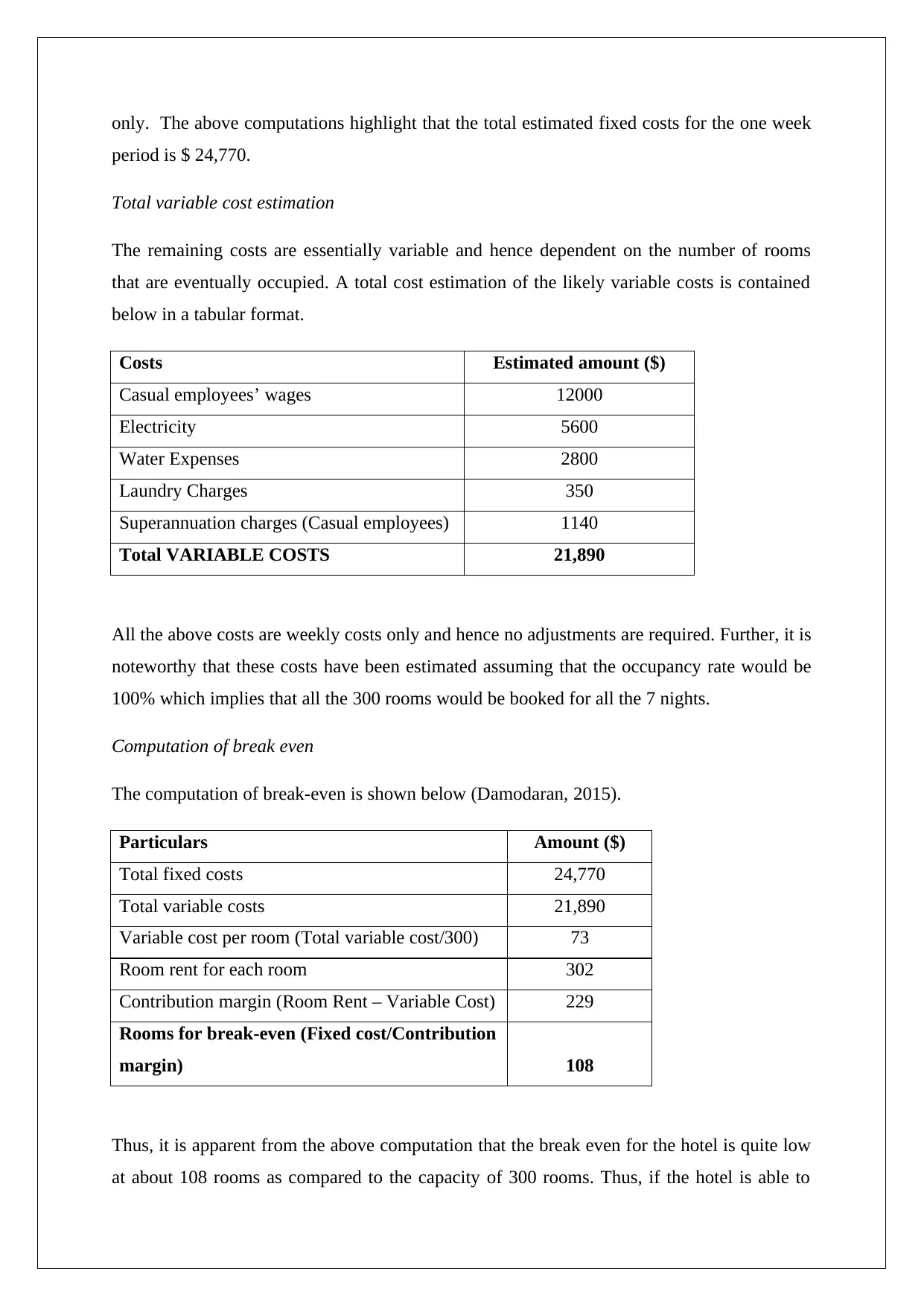
only. The above computations highlight that the total estimated fixed costs for the one week
period is $ 24,770.
Total variable cost estimation
The remaining costs are essentially variable and hence dependent on the number of rooms
that are eventually occupied. A total cost estimation of the likely variable costs is contained
below in a tabular format.
Costs Estimated amount ($)
Casual employees’ wages 12000
Electricity 5600
Water Expenses 2800
Laundry Charges 350
Superannuation charges (Casual employees) 1140
Total VARIABLE COSTS 21,890
All the above costs are weekly costs only and hence no adjustments are required. Further, it is
noteworthy that these costs have been estimated assuming that the occupancy rate would be
100% which implies that all the 300 rooms would be booked for all the 7 nights.
Computation of break even
The computation of break-even is shown below (Damodaran, 2015).
Particulars Amount ($)
Total fixed costs 24,770
Total variable costs 21,890
Variable cost per room (Total variable cost/300) 73
Room rent for each room 302
Contribution margin (Room Rent – Variable Cost) 229
Rooms for break-even (Fixed cost/Contribution
margin) 108
Thus, it is apparent from the above computation that the break even for the hotel is quite low
at about 108 rooms as compared to the capacity of 300 rooms. Thus, if the hotel is able to
period is $ 24,770.
Total variable cost estimation
The remaining costs are essentially variable and hence dependent on the number of rooms
that are eventually occupied. A total cost estimation of the likely variable costs is contained
below in a tabular format.
Costs Estimated amount ($)
Casual employees’ wages 12000
Electricity 5600
Water Expenses 2800
Laundry Charges 350
Superannuation charges (Casual employees) 1140
Total VARIABLE COSTS 21,890
All the above costs are weekly costs only and hence no adjustments are required. Further, it is
noteworthy that these costs have been estimated assuming that the occupancy rate would be
100% which implies that all the 300 rooms would be booked for all the 7 nights.
Computation of break even
The computation of break-even is shown below (Damodaran, 2015).
Particulars Amount ($)
Total fixed costs 24,770
Total variable costs 21,890
Variable cost per room (Total variable cost/300) 73
Room rent for each room 302
Contribution margin (Room Rent – Variable Cost) 229
Rooms for break-even (Fixed cost/Contribution
margin) 108
Thus, it is apparent from the above computation that the break even for the hotel is quite low
at about 108 rooms as compared to the capacity of 300 rooms. Thus, if the hotel is able to

book 108 rooms for the week, the hotel would be able to break even. Any incremental
bookings would bring in profit for the hotel.
Task 3
Target profit implementation
It is apparent that the fixed cost would not change irrespective of the number of rooms
booked. Hence, the relevant cost for the achievement of profit would be primarily the
variable costs to serve the clients. It is imperative to analyse the two offers that have been
offered to the hotel from two different travel agents (Arnold, 2015).
Option A: The profit would be $50,000 as per this plan
In order to generate, the above amount of profit, the number of rooms that the hotel would
have to book need to be determined.
Particulars Amount ($)
Total fixed costs 24,770
Total variable costs 21,890
Variable cost per room (Total variable cost/300) 73
Room rent for each room 302
Contribution margin 229
Targeted profit 50,000
Rooms required for targeted profit 326
It is apparent from above that if the company intends to generate $ 50,000 profit, then the
number of rooms that need to be booked by the hotel would have to be 326 or greater than the
rooms available. Clearly, this is not feasible and hence it makes sense for the hotel
management to accept this offer.
Option B: The profit would be $30,000 as per this plan
In order to generate, the above amount of profit, the number of rooms that the hotel would
have to book need to be determined.
Particulars Amount ($)
Total fixed costs 24,770
bookings would bring in profit for the hotel.
Task 3
Target profit implementation
It is apparent that the fixed cost would not change irrespective of the number of rooms
booked. Hence, the relevant cost for the achievement of profit would be primarily the
variable costs to serve the clients. It is imperative to analyse the two offers that have been
offered to the hotel from two different travel agents (Arnold, 2015).
Option A: The profit would be $50,000 as per this plan
In order to generate, the above amount of profit, the number of rooms that the hotel would
have to book need to be determined.
Particulars Amount ($)
Total fixed costs 24,770
Total variable costs 21,890
Variable cost per room (Total variable cost/300) 73
Room rent for each room 302
Contribution margin 229
Targeted profit 50,000
Rooms required for targeted profit 326
It is apparent from above that if the company intends to generate $ 50,000 profit, then the
number of rooms that need to be booked by the hotel would have to be 326 or greater than the
rooms available. Clearly, this is not feasible and hence it makes sense for the hotel
management to accept this offer.
Option B: The profit would be $30,000 as per this plan
In order to generate, the above amount of profit, the number of rooms that the hotel would
have to book need to be determined.
Particulars Amount ($)
Total fixed costs 24,770
⊘ This is a preview!⊘
Do you want full access?
Subscribe today to unlock all pages.

Trusted by 1+ million students worldwide
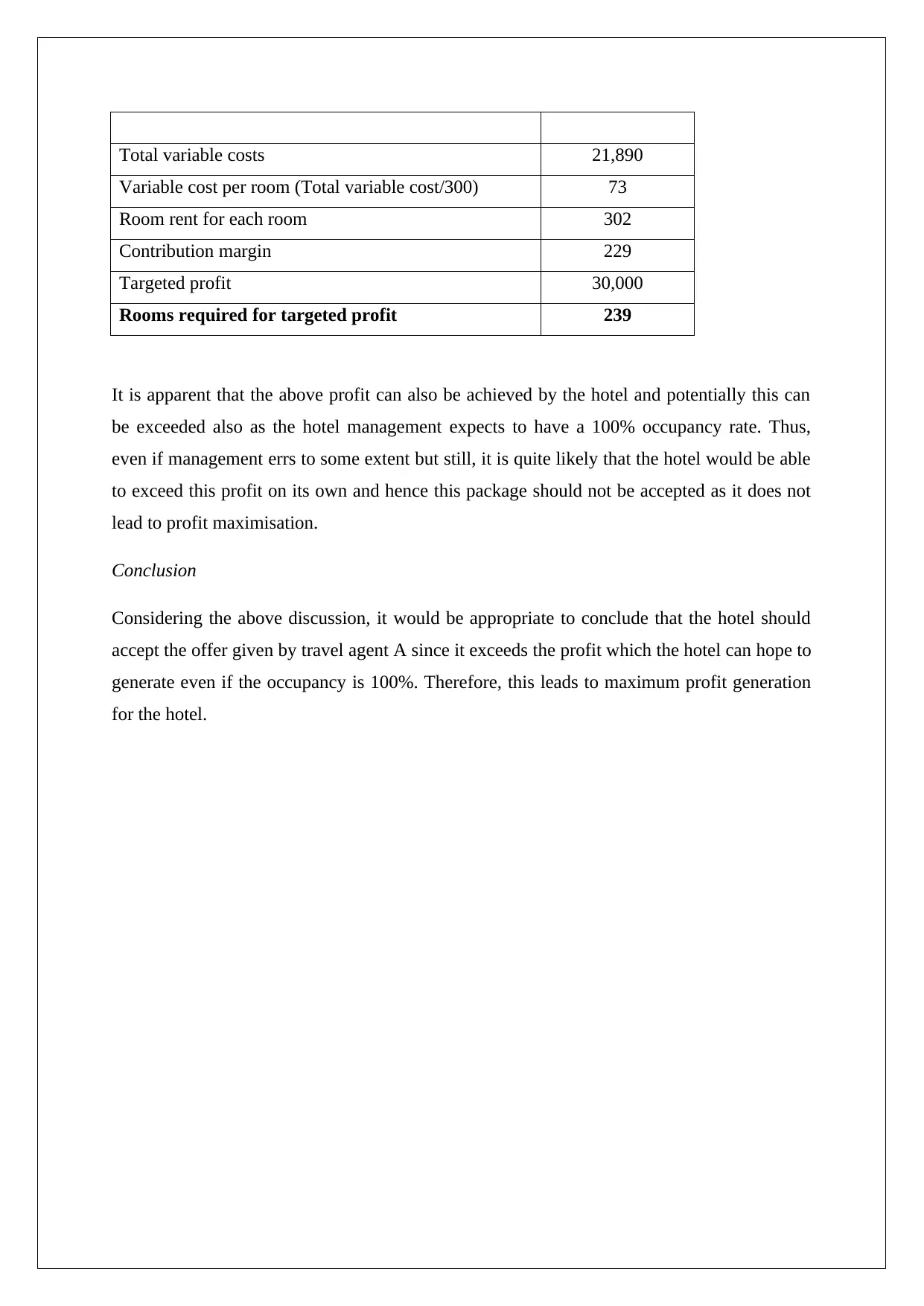
Total variable costs 21,890
Variable cost per room (Total variable cost/300) 73
Room rent for each room 302
Contribution margin 229
Targeted profit 30,000
Rooms required for targeted profit 239
It is apparent that the above profit can also be achieved by the hotel and potentially this can
be exceeded also as the hotel management expects to have a 100% occupancy rate. Thus,
even if management errs to some extent but still, it is quite likely that the hotel would be able
to exceed this profit on its own and hence this package should not be accepted as it does not
lead to profit maximisation.
Conclusion
Considering the above discussion, it would be appropriate to conclude that the hotel should
accept the offer given by travel agent A since it exceeds the profit which the hotel can hope to
generate even if the occupancy is 100%. Therefore, this leads to maximum profit generation
for the hotel.
Variable cost per room (Total variable cost/300) 73
Room rent for each room 302
Contribution margin 229
Targeted profit 30,000
Rooms required for targeted profit 239
It is apparent that the above profit can also be achieved by the hotel and potentially this can
be exceeded also as the hotel management expects to have a 100% occupancy rate. Thus,
even if management errs to some extent but still, it is quite likely that the hotel would be able
to exceed this profit on its own and hence this package should not be accepted as it does not
lead to profit maximisation.
Conclusion
Considering the above discussion, it would be appropriate to conclude that the hotel should
accept the offer given by travel agent A since it exceeds the profit which the hotel can hope to
generate even if the occupancy is 100%. Therefore, this leads to maximum profit generation
for the hotel.
Paraphrase This Document
Need a fresh take? Get an instant paraphrase of this document with our AI Paraphraser
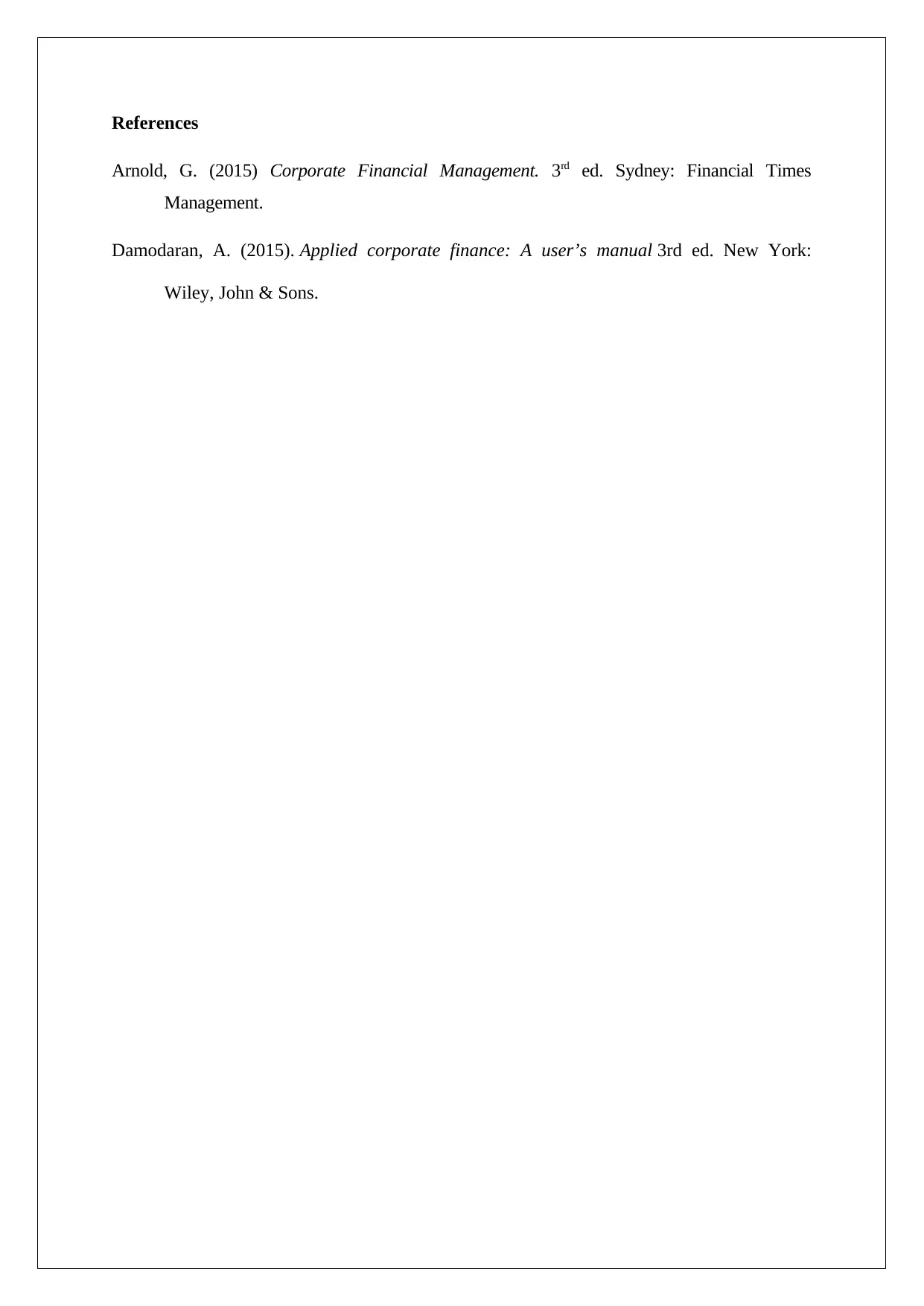
References
Arnold, G. (2015) Corporate Financial Management. 3rd ed. Sydney: Financial Times
Management.
Damodaran, A. (2015). Applied corporate finance: A user’s manual 3rd ed. New York:
Wiley, John & Sons.
Arnold, G. (2015) Corporate Financial Management. 3rd ed. Sydney: Financial Times
Management.
Damodaran, A. (2015). Applied corporate finance: A user’s manual 3rd ed. New York:
Wiley, John & Sons.
1 out of 8
Your All-in-One AI-Powered Toolkit for Academic Success.
+13062052269
info@desklib.com
Available 24*7 on WhatsApp / Email
![[object Object]](/_next/static/media/star-bottom.7253800d.svg)
Unlock your academic potential
Copyright © 2020–2025 A2Z Services. All Rights Reserved. Developed and managed by ZUCOL.

